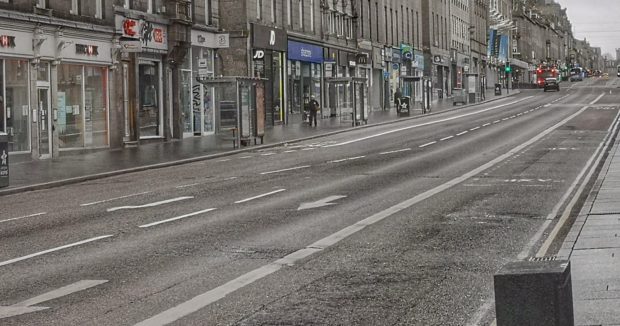Campaigners say plummeting levels of air pollution in Aberdeen city centre during lockdown offer a glimpse into a greener future where vehicles are banned from certain streets.
The Air Quality In Scotland organisation claims the deserted roads “provide an opportunity to investigate what improved air quality within Scotland’s cities could look like in the future”.
Vehicles are the main source of harmful gases like nitrogen dioxide, which is monitored at various roadside points across the Granite City including on Union Street.
Comparing the first week in April 2019 to the same week this year, the experts showed the average nitrogen dioxide concentration in the city’s main thoroughfare fell from 39 micrograms per cubic meter of air to 17, a reduction of 56%.
Similar decreases have been recorded in the three other largest Scottish cities, with carbon dioxide levels falling by 57% in Edinburgh’s St John’s Road, 73% in Glasgow’s Hope Street and 43% in Lochee Road in Dundee.
While the fall might have been predictable given the lack of cars on the road during lockdown, environmental campaigners said it should not have taken the “absolute horror” of the pandemic to illustrate how steep the decline would be.
In February, city councillors pushed forward with plans for a public consultation to be held into the proposed low emissions zone (LEZ) where certain vehicles are banned from parts of the heart of Aberdeen or charged for entry.
George Street and Harbour councillor Dell Henricksen, who highlighted the figures, said: “This just shows what we could do– my only concern is how quickly levels will rise again when the lockdown is over.
“These figures show the improvements a LEZ in Aberdeen could bring although it’s obviously very unfortunate this has come about because of the current situation.”
Council transport spokeswoman Sandra Macdonald added: “Having more people walking and cycling in Union Street makes for a more pleasant space and would be preferable going forward, as well as having good public transport.
“It’s not a surprise that air quality has improved so drastically, not just in Union Street but Market Street too – but it currently comes at a huge cost to local business.
“Maybe this situation has shown we can have a city centre with far fewer cars and hopefully environmentally friendly habits will stay with people once this is all over.”
Restrictions have also led to more members of the public opting for greener methods of travel in the Highlands, a move one politician has said may lead a charge for change at the end of the pandemic.
Inverness, Nairn, Badenoch and Strathspey MP Drew Hendry has said the increase in Highlanders getting out and about on foot “could provide the stepping stones to a healthier future”, with efforts to look out for one another during the pandemic assisting to “strengthen the long-held community spirit of the Highlands”.
